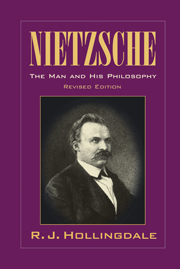17 - Nietzsche's Death
from PART IV - 1889-1900
Published online by Cambridge University Press: 13 September 2019
Summary
… he will be misunderstood and for a long time thought an ally of powers he abhors. (UIII 4)
To the story of Nietzsche's life must be added the story of his death. He took eleven years to die, and in that time he became a figure of legend: living yet dead, existing in a world beyond human reach, he excited to a dangerous degree the myth-making powers of a nation increasingly addicted to fantasy and irrationalism. The Nietzsche for whom the Nazis built the museum at Weimar was, in all strictness, a madman: the Nietzsche of the last eleven years, transformed from a rational philosopher and writer of genius into a man without qualities upon whom any characteristics might be put. The reality— that the philosopher had succumbed to an infection, most probably syphilitic, and was declining into a condition usually called general paralysis of the insane—disappeared in the fog of confusion, self-deception and gobbledegook which had been drifting down upon the Reich since its inception and against which Nietzsche himself had constantly and vociferously warned; so that at last Ernst Bertram, a prominent member of Stefan George's ‘Circle’, called Nietzsche's insanity an ‘ascent into the mystic’ and a ‘proud transition’ to a higher state. The content of Nietzsche's life-work was abolished, his breach with Wagner healed, his enmity towards the Reich explained away: he was made into ‘an ally of powers he abhors’ (UIII 4). The process was taken so far that he became identified with the ultimate heirs of the movement against which he had from the first set his face: with anti-Semitic, race- and stateworshipping, anti-rationalist Nazism. ‘His followers,’ wrote Bertrand Russell towards the end of the Second World War, ‘have had their innings’: the phraseology is as English as the misapprehension was universal.
It cannot be denied that Nietzsche was in some degree infected by the word- and myth-spinning tendencies of his nation and age; but it must also be asserted that he fought them, and that his anti-Germanism was, at bottom, the outward sign of an inward struggle.
- Type
- Chapter
- Information
- NietzscheThe Man and His Philosophy Revised Edition, pp. 243 - 254Publisher: Cambridge University PressPrint publication year: 1999



